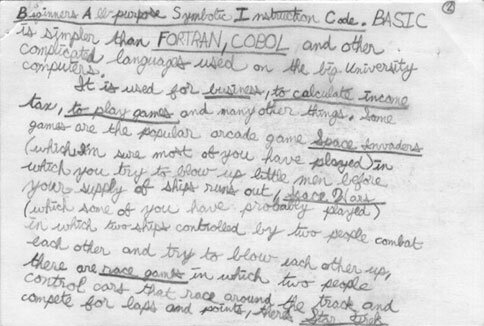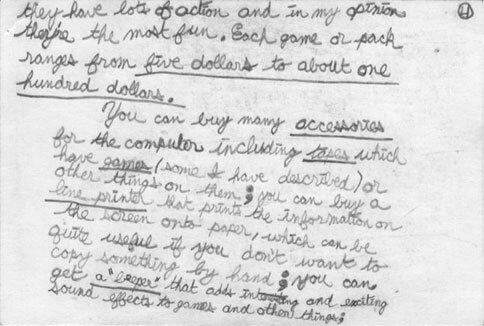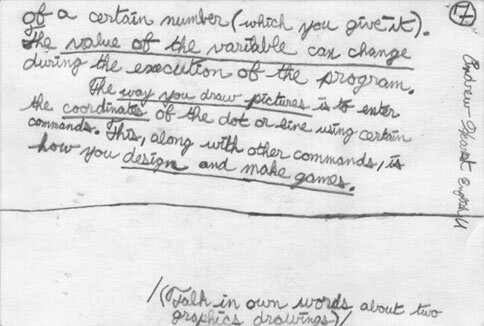Blog.
My Sixth-Grade TRS-80 Speech, 1980
DECEMBER 9, 2005
In 1979, when I was 10, my father bought a Radio Shack TRS-80 for my family. The TRS-80 was an attempt by Tandy, Radio Shack’s parent company, to enter the burgeoning home-computer market. It was a rickety, cheaply made little thing that totally earned its derisive nickname, “Trash 80.” But I was fascinated by what it could do.
Those were the days of Asteroids and Space Invaders; my friends and I were part of the first generation of children to grow up obsessed with videogames. When my dad brought the TRS-80 home, I was convinced it would be like having an entire arcade of awesome videogames in my bedroom. That was not, um, the case. My version of the TRS-80 had something like one kilobyte of memory—no joke—and didn’t utilize a disk drive; you loaded programs into its memory using a standard audiocassette player. But I still had fun with the thing. I remember programming it to play back a funk-free rendition of “The Hustle” comprised entirely of staccato eighth-note ticks and bleeps. God, I was so fucking cool.
Anyway, getting to the point: I was assigned an oral report in my sixth-grade English class a year or so after we got the computer, and I chose to talk about my TRS-80. I still have the notecards from that oral report—see below—and they’re pretty hilarious, and not just because my handwriting is totally freakish. In the last few years, I’ve re-created this speech in front of New York audiences three or four times, most prominently at a 2003 installment of my brilliant Upper West Side neighbor John Hodgman‘s Little Gray Book series. I read two oral reports from my childhood and adolescence that night; the other one was my 10th-grade Led Zeppelin report, which I posted about here.
(For the record, my computer-geek period only lasted a year or two. By 1981 or 1982 I had lost interest in computers—though not videogames—and I didn’t really start using them again until the early ‘90s, right after I graduated from college. During my undergrad years I wrote my papers by hand in notebooks and then stayed up late typing them on my electric typewriter while listening to every Van Morrison LP in my collection—and reaching for Liquid Paper when I made a mistake. Ah, good times.)
Here are my two favorite lines from the report:
[Y]ou can buy a line printer that prints the information on the screen onto paper, which can be quite useful if you don’t want to copy something by hand.
[...]
Another way to save and/or load in programs is with floppy disks, which are square disks that are floppy.
Here are the seven notecards. I’ve posted a full transcript at the end of this post, in case you find my freakish handwriting unreadable.
Yes, I put slashes through my zeros back in those days.
Here’s a full transcript of the notecards:
THE RADIO SHACK TRS-80 COMPUTER
BY ANDREW HEARST
ENGLISHAbout a year ago, my family bought a Radio Shack TRS-80 that can calculate and create games along with many other things. Some reasons why we bought it are so my father could do experiments on it and so my sisters and I could have fun playing the games. One reason why I wanted to buy it was so I could do my math homework on it. Unfortunately, my parents wouldn’t let me. If you like this, speech, tell your parents to consider buying you one for Christmas. They’re only eight hundred fifty dollars!
The computer is composed of a keyboard like a typewriter’s, a video display that resembles a television, and a regular tape recorder you use to save or load in programs from tape.
There are many different languages for different computers. The TRS-80 uses BASIC, which stands for Beginners All-purpose Symbolic Instruction Code. BASIC is simpler than FORTRAN, COBOL and other complicated languages used on the big university computers.
It is used for business, to calculate income tax, to play games and many other things. Some games are the popular arcade game Space Invaders (which I’m sure most of you have played) in which you try to blow up little men before your supply of ships runs out, Space Wars (which some of you have probably played) in which two ships controlled by two people combat each other and try to blow each other up, there are race games in which two people control cars that race around the track and compete for laps and points, there’s Star Trek in which you try to blow up about forty Klingons before you run out of fuel or get destroyed, and there’s Star Wars in which you try to blow up between 18 and 21 TIE fighters and then you try to blow up Darth Vader and the Death Star. And there are many, many more action games. There are basketball, football, baseball, and other sports games. There are also educational tape packs with math and algebra and many other packs including an IQ builder. My favorites out of the games I have mentioned are Space Invaders and Star Wars because they have lots of action and in my opinion they’re the most fun. Each game or pack ranges from five dollars to about one hundred dollars.
You can buy many accessories for the computer including tapes which have games (some I have described) or other things on them; you can buy a line printer that prints the information on the screen onto paper, which can be quite useful if you don’t want to copy something by hand; you can get a “beeper” that adds interesting and exciting sound effects to games and other things; you can have memory chips installed to add to the computer’s memory and capability plus you can buy many, many more interesting things for the computer.
Another way to save and/or load in programs is with floppy disks, which are square disks that are floppy. Instead of using a tape recorder, though, you use what’s called a disk drive, which is a box that you slide the disk into. It is much, much faster than using tapes.
There is a different kind of TRS-80 that you can hook up to a television that has high resolution graphics and color. High resolution graphics are really thin lines so you can draw pictures in detail.
But now, getting back to the regular TRS-80, there is a Level I and a Level II. The Level I isn’t very complex but the Level II has about five times as many commands as Level I, so it is much better.
A set of commands is called a program. Some commands are RUN, which executes the program; LIST, which lists the program’s lines; and NEW, which clears the memory.
To write a program, you sometimes have to use variables. A variable is represented by a letter, which contains the value of a certain number (which you give it). The value of the variable can change during the execution of the program.
The way you draw pictures is to enter the coordinates of the dot or line using certain commands. This, along with other commands, is how you design and make games.
(Talk in own words about two graphics drawings)







